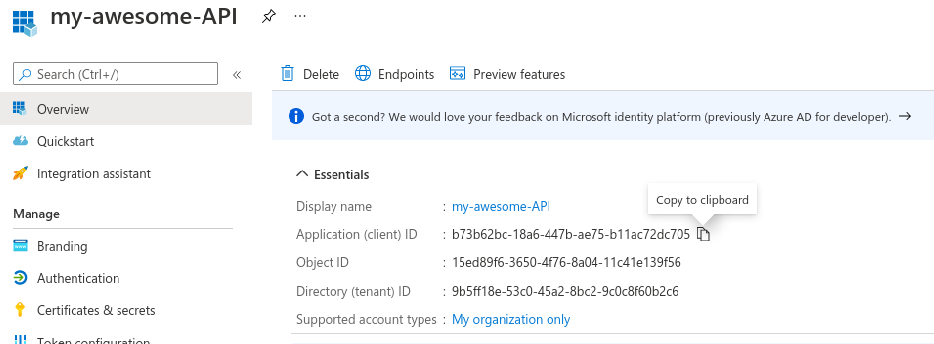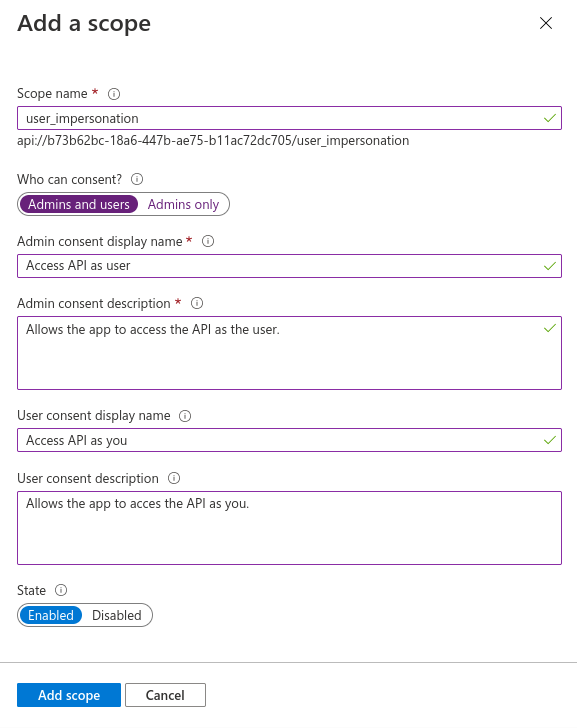Azure configuration
We'll need to create two application registrations for Azure Entra ID authentication to cover both direct API use and usage from the OpenAPI (swagger) documentation.
We'll start with the API.
Backend API
Step 1 - Create app registration
Head over to Azure -> Azure Active Directory -> App registrations, and create a new registration.
Select a fitting name for your project; Azure will present the name to the user during consent.
Supported account types:Single tenant- If you want to create a multi-tenant application, you should head over to the multi-tenant documentation
Press Register

Step 2 - Change token version to v2
First we'll change the token version to version 2. In the left menu bar, click Manifest and find the line
that says requestedAccessTokenVersion. Change its value from null to 2.
Press Save
(This change can take some time to happen, which is why we do this first.)

Step 3 - Note down your application IDs
Go back to the Overview, found in the left menu.
Copy the Application (Client) ID and Directory (tenant) ID, we'll need these for later. I like to use .env files to
store variables like these:
TENANT_ID=
APP_CLIENT_ID=
OPENAPI_CLIENT_ID=

Step 4 - Add an application scope
- Go to Expose an API in the left menu bar under your app registration.
- Press + Add a scope
- You'll be prompted to set an Application ID URI, leave the suggested one and press Save and continue

Add a scope named user_impersonation that can be consented by Admins and users.
You can use the following descriptions:
Access API as user
Allows the app to access the API as the user.
Access API as you
Allows the app to access the API as you.

OpenAPI Documentation
Our OpenAPI documentation will use the Authorization Code Grant Flow, with Proof Key for Code Exchange flow.
It's a flow that enables a user of a Single-Page Application to safely log in, consent to permissions and fetch an access_token
in the JWT format. When the user clicks Try out on the APIs, the access_token is attached to the header as a Bearer token.
This is the token the backend will validate.
So, let's set it up!
Step 1 - Create app registration
Just like in the previous chapter, we have to create an application registration for our OpenAPI.
Head over to Azure -> Azure Active Directory -> App registrations, and create a new registration.
Use the same name, but with - OpenAPI appended to it.
Supported account types:Single tenantRedirect URI: ChooseSingle-Page Application (SPA)andhttp://localhost:8000/oauth2-redirectas a value
Press Register

Step 2 - Change token version to v2
Like last time, we'll change the token version to version 2. In the left menu bar, click Manifest and find the line
that says requestedAccessTokenVersion. Change its value from null to 2.
Press Save

Step 3 - Note down your application IDs
Go back to the Overview, found in the left menu.
Copy the Application (Client) ID and save it as your OPENAPI_CLIENT_ID:
TENANT_ID=
APP_CLIENT_ID=
OPENAPI_CLIENT_ID=

Step 4 - Allow OpenAPI to talk to the backend
To allow OpenAPI to talk to the backend API, you must add API permissions to the OpenAPI app registration. In the left menu, go to API Permissions and Add a permission.

Select the user_impersonation scope, and press Add a permission.
Your view should now look something like this:

That's it! Next step is to configure the FastAPI application.